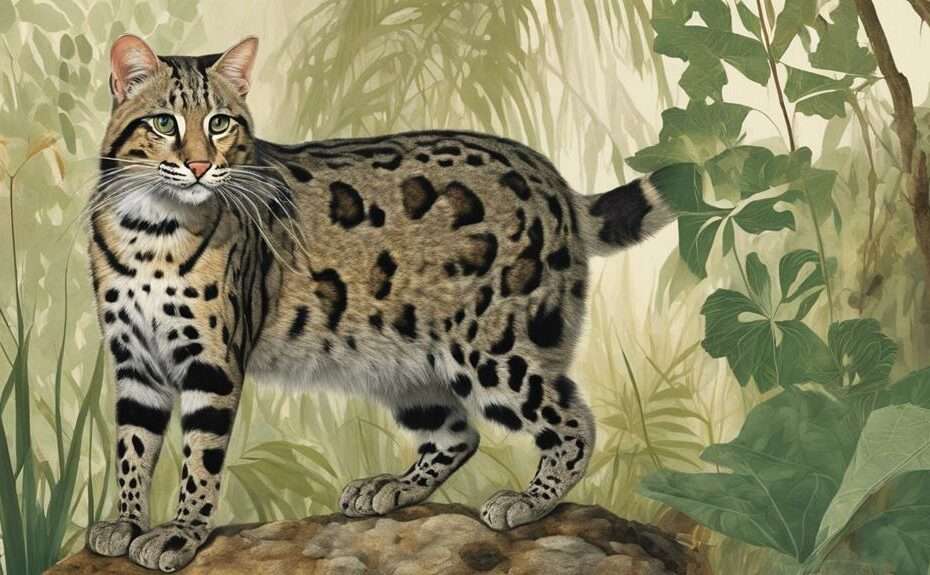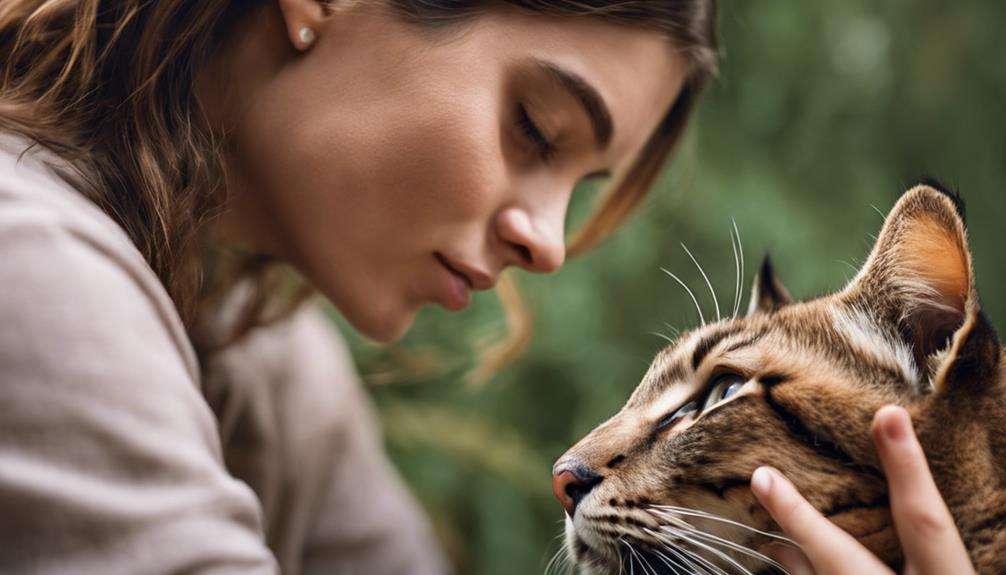When exploring the realm of wild cats, you may have encountered some of the more popular species, but have you truly uncovered the hidden gems among these majestic felines?
The list of 10 best lesser-known wild cat species holds a treasure trove of captivating creatures waiting to be discovered. Each of these elusive cats has its own distinct charm and remarkable adaptations that set them apart from their more famous relatives.
Prepare to be intrigued as we unravel the mysteries surrounding these lesser-known wild cat species and their fascinating lives in the untamed wilderness.
Key Takeaways
- Black-footed Cat: Africa's smallest, resilient nocturnal hunter facing urgent conservation needs.
- Pallas Cat & Flat-headed Cat: Asian wild cats with unique adaptations requiring conservation efforts.
- Iberian Lynx: From near extinction to thriving, showcasing successful conservation through habitat protection.
- Fishing Cat: Water environment specialist facing habitat threats, highlighting crucial conservation efforts.
Black-footed Cat
The Black-footed Cat, the smallest wild cat in Africa, weighs only four pounds. This nocturnal hunter, found in the arid regions of South Africa, Namibia, and Botswana, is an elusive species that prowls the night in search of prey. Despite its small size, the Black-footed Cat is a mighty and efficient predator, capable of catching more prey in one night than a leopard does in six months. Its survival is crucial as it faces a vulnerable status in the wild, prompting urgent conservation efforts to protect this remarkable feline species.
The Black-footed Cat's adaptability to the harsh conditions of the African wilderness showcases its resilience and prowess. With a keen sense of sight and hearing, it navigates the darkness with ease, making it a formidable hunter in its habitat. Conservationists are working tirelessly to safeguard the future of this species, recognizing its importance in maintaining the delicate balance of ecosystems in Africa. Through conservation efforts, there's hope that the Black-footed Cat will continue to roam the arid lands of Africa for generations to come.
Iberian Lynx
The Iberian Lynx, once on the brink of extinction, has made a remarkable comeback thanks to dedicated conservation efforts.
With its unique tufted ears and specialized hunting skills, these medium-sized cats are a sight to behold in the wild.
The preservation of their natural habitats and successful captive breeding programs have been key factors in ensuring the survival of this iconic species.
Conservation Efforts
In the ongoing mission to protect the Iberian lynx, significant strides have been made through targeted conservation efforts. Once the most endangered wild cat species with fewer than 100 individuals in 2002, the population now exceeds 1,000, thanks to dedicated conservation initiatives.
These efforts include habitat protection and successful captive breeding programs. The Iberian lynx, a highly specialized species native to Spain and Portugal, relies heavily on preying on rabbits and faces threats from habitat loss and fragmentation.
The positive outcomes from the conservation programs for the Iberian lynx not only showcase the importance of preserving this unique cat but also provide a blueprint for other endangered species recovery programs to follow.
Unique Physical Features
With tufted ears and a distinctive spotted coat, the Iberian Lynx captivates with its unique physical features. This wild cat, once the most endangered in 2002, now boasts a population exceeding 1,000 individuals due to successful conservation efforts, including habitat protection and captive breeding programs. Found in Spain and Portugal, the Iberian Lynx thrives in Mediterranean habitats, preying primarily on rabbits.
Its striking tufted ears and beautiful spotted coat set it apart from other wild cat species, highlighting its endangered status and the importance of dedicated conservation initiatives. The Iberian Lynx's conservation success story serves as a beacon of hope for the preservation of endangered species worldwide.
Pallas Cat
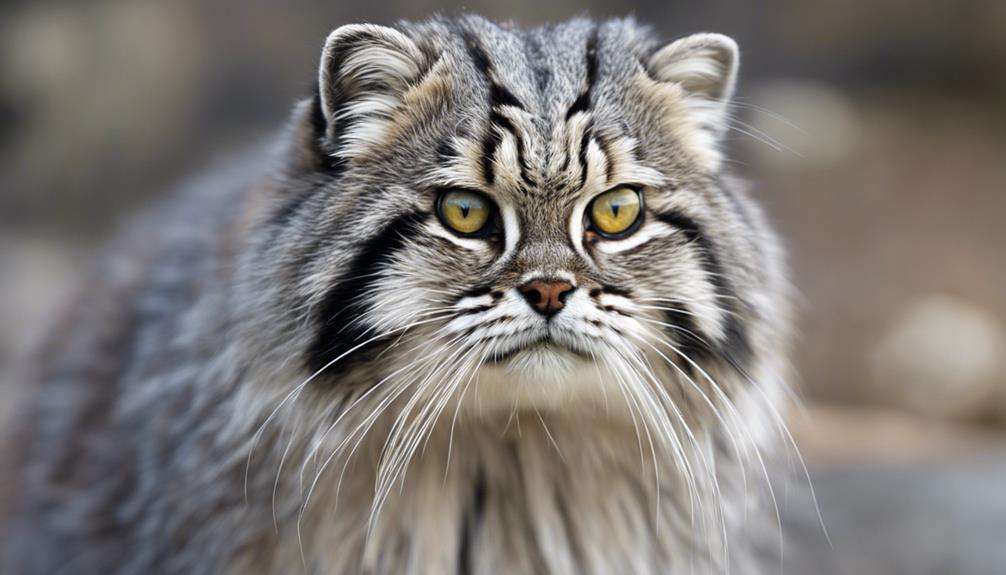
At higher elevations in Central Asia, including Mongolia and parts of Russia, roams the Pallas Cat, a wild feline known for its fluffy coat and unique rocky habitat camouflage. These elusive cats are perfectly adapted to their environment, with a thick coat that helps them blend seamlessly into the rocky terrains where they reside. Pallas Cats, as ambush predators, rely on their excellent camouflage to sneak up on small mammals such as pikas and voles.
With their small ears designed to reduce heat loss in the cold mountainous regions they inhabit, Pallas Cats are well-suited for the harsh climates they call home. However, despite their adaptations, these cats face threats from habitat loss and poaching. Conservation efforts are essential to safeguard the Pallas Cat and ensure that they continue to thrive in the wild.
Fishing Cat
Camouflaged amidst the lush swamps and wetlands of Southeast Asia, the Fishing Cat prowls with unparalleled aquatic prowess, distinguishing itself through its larger size and remarkable fishing abilities. This wild cat species is equipped with webbed feet, enabling it to navigate water bodies effortlessly and making it an exceptional swimmer.
The Fishing Cat's unique adaptations for swimming and catching fish set it apart from other feline species, showcasing its specialization in hunting aquatic prey.
- The Fishing Cat, larger than domestic cats, thrives in the swamps and wetlands of Southeast Asia.
- Its webbed feet facilitate excellent swimming capabilities, aiding in its pursuit of fish, rodents, and birds.
- Habitat loss and degradation pose significant threats to the Fishing Cat, leading to a concerning decline in populations. Conservation efforts are vital to safeguard this species and its habitat from further deterioration.
Flat-headed Cat
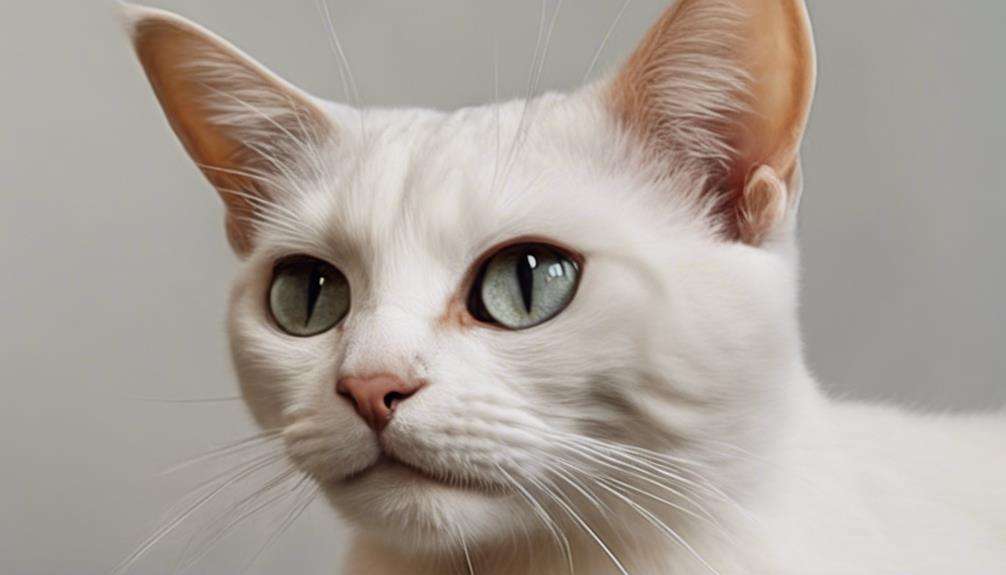
The flat-headed cat, a rare and endangered species from Southeast Asia, stands out for its distinctive flattened head. This unique physical feature aids in its hunting abilities in water. These cats have specialized adaptations that enable them to thrive in wetland environments. They primarily prey on fish, crustaceans, and frogs.
However, habitat destruction and pollution pose severe threats to the survival of flat-headed cats. Conservation efforts are crucial for their future existence.
Unique Physical Features
With eyes positioned close together to enable stereoscopic vision and webbed feet facilitating movement on both muddy ground and water, the Flat-headed Cat possesses unique physical features that enhance its adaptability to semi-aquatic habitats. This wild cat, perfectly suited for wetlands, preys on fish, crustaceans, and frogs with its specialized hunting skills. The remarkable abilities of the Flat-headed Cat include:
- Stereoscopic Vision: Their close-set eyes allow for accurate depth perception, aiding in hunting prey both on land and in water.
- Webbed Feet: These unique feet enable the cat to navigate through muddy terrain and swim efficiently, making it a proficient semi-aquatic hunter.
- Adaptation to Wetlands: The Flat-headed Cat's physical features are specifically designed to thrive in wetland environments, showcasing its remarkable evolutionary traits.
Conservation Status
Endangered according to the IUCN Red List, the Flat-headed Cat faces a declining population primarily due to habitat destruction and pollution. This small wild cat species thrives in semi-aquatic habitats, often residing in wetlands. With a specialized diet consisting of fish, crustaceans, and frogs, the Flat-headed Cat is uniquely adapted to its environment.
Conservation efforts are crucial in preserving this species, focusing on protecting its wetland habitats from further degradation. By addressing the threats of habitat loss and pollution, there's hope for the survival of the Flat-headed Cat.
It's essential to raise awareness about the plight of this Endangered species and work towards sustainable solutions to ensure its continued existence in the wild.
Oncilla
Elusive and small, the Oncilla prowls the forests of Central and South America, its vulnerable population warranting conservation efforts. This small wild cat, also known as the tigrillo, is a rare sight due to its secretive nature and dwindling numbers in the wild.
- Conservation Efforts: Dedicated initiatives are in place to protect the Oncilla, utilizing innovative methods like camera traps to monitor their behavior and population trends.
- Reintroduction Programs: The Oncilla is a prime candidate for reintroduction projects, with plans to bolster its numbers in regions like the U.S. borderlands where suitable habitats exist.
- Community Involvement: Engaging local communities in conservation efforts plays a crucial role in safeguarding the Oncilla, fostering awareness and support for the species' protection.
Efforts are ongoing to ensure the survival of this enchanting feline species, highlighting the importance of preserving the delicate balance of ecosystems where the Oncilla thrives.
Geoffroy's Cat
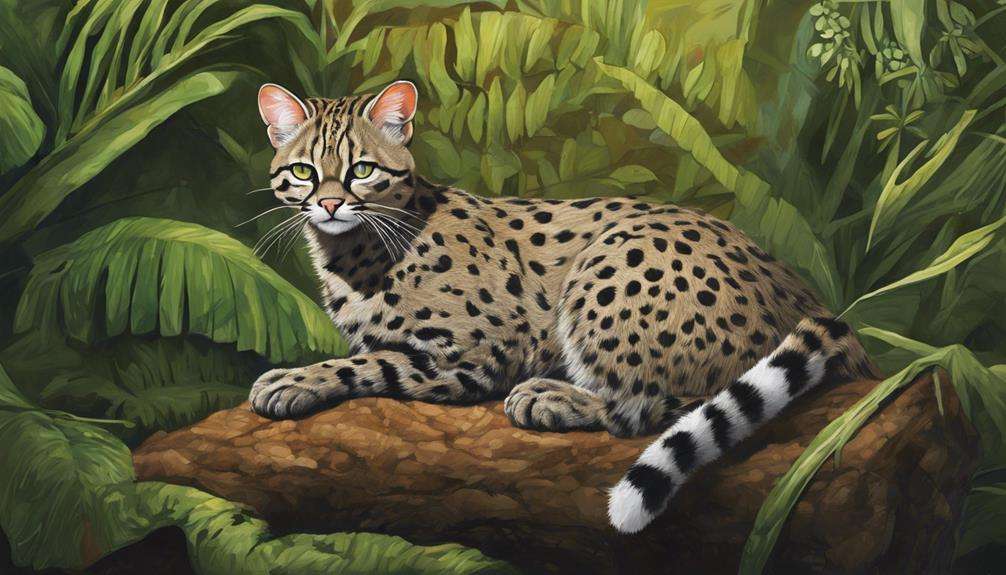
Known for its distinctive appearance and preference for dense habitats, the Geoffroy's Cat is a small wild feline species commonly found in Southern Bolivia to the Straits of Magellan. These elusive cats boast a beautiful brown, fuzzy coat that helps them blend seamlessly into their surroundings, making them challenging to spot in the wild. Despite their elusive nature, Geoffroy's Cats aren't considered rare and can be found throughout their range.
One remarkable feature of the Geoffroy's Cat is its agility. These small wild cats are capable of standing on their back legs, using their tail for balance, which showcases their remarkable balance and coordination. This unique ability aids them in navigating their dense habitats with ease, allowing them to move swiftly and stealthily through the undergrowth.
The Geoffroy's Cat's adaptability to various environments, combined with its stunning appearance and impressive agility, make it a fascinating species for wildlife enthusiasts to observe in its natural habitat.
Jaguarundi
The Jaguarundi, a sleek and agile wild cat species known for its unique appearance and diurnal hunting habits, can be found ranging from southern Texas to South America. These small wild cats exhibit a fascinating set of characteristics:
- Unique Appearance: With a long tail, short legs, and a uniform fur color ranging from dark gray to rusty brown, the Jaguarundi stands out among other wild cat species.
- Efficient Hunting Skills: Known for their agile hunting techniques, Jaguarundis rely on stealth and speed to capture their prey, which mainly includes small vertebrates, fish, and amphibians.
- Habitat Loss and Population Declines: Despite their widespread distribution, Jaguarundis are facing threats from habitat loss, fragmentation, and hunting activities. These factors have contributed to population declines in certain regions, highlighting the importance of conservation efforts to protect this remarkable species.
The Jaguarundi's adaptability and distinctive traits make it a captivating subject for those interested in the lesser-known wild cat species.
Sand Cat
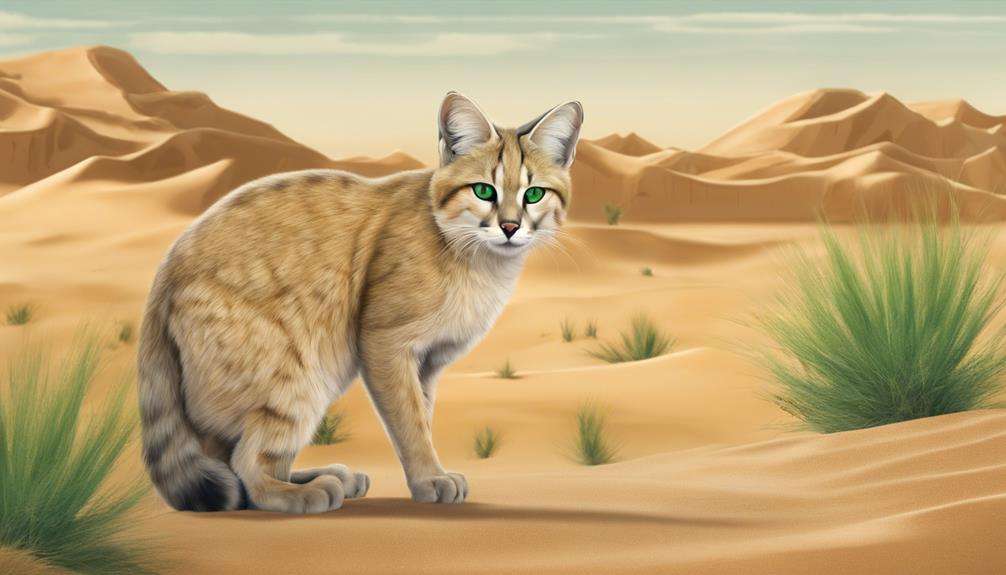
You'll be intrigued by the unique features of the Sand Cat, such as its dense foot pad fur that shields it from scorching desert sands.
This small wild cat species has adapted remarkably to survive in harsh desert environments, showcasing its resilience against high temperatures and limited water sources.
Discover more about the Sand Cat's habitat preferences and how it thrives in some of the most extreme conditions in Africa and Asia.
Unique Sand Cat Features
Adapted to thrive in the harsh desert landscapes of the Sahara, the Sand Cat, scientifically known as Felis margarita, possesses remarkable features that aid its survival in extreme conditions. This elusive feline showcases unique characteristics that set it apart in the wild:
- Large Ears: Sand Cats boast oversized ears that not only enhance their exceptional hearing but also help dissipate excess body heat in their arid habitat.
- Nocturnal Behavior: Being active during the night allows these cats to avoid the scorching heat of the desert sun while efficiently hunting small mammals, birds, and insects.
- Specialized Paw Fur: The Sand Cat's paws are covered in dense fur, protecting them from the hot desert sand and providing traction on loose surfaces.
Sand Cat Habitat Preferences
Nestled within the vast expanse of arid deserts and semi-deserts, the Sand Cat exhibits a remarkable affinity for extreme climates, showcasing unparalleled adaptability to thrive in harsh desert landscapes.
These elusive felines are well-suited to the arid desert environments, where they navigate the shifting sands with ease. Sand Cats endure the scorching heat of the day and the chilly nights, thanks to their exceptional ability to withstand extreme temperatures.
As nocturnal hunters, they utilize their keen senses to hunt small mammals under the veil of darkness. Their sandy-colored fur blends seamlessly with the desert surroundings, providing them with effective camouflage as they prowl the dunes.
Despite their petite size, Sand Cats are efficient predators, preying on small mammals with precision and grace.
Andean Cat
Endangered due to habitat loss and human activities, the Andean Cat, a small wild feline endemic to the Andes Mountains, remains one of the least studied and rarest wild cat species. This elusive cat, also known as the Andean Mountain Cat, has captured the fascination of wildlife enthusiasts and conservationists alike for its unique characteristics:
- Distinctive Appearance: The Andean Cat stands out with its thick fur coat, long tail, and striking facial markings.
- Conservation Focus: Efforts to protect the Andean Cat revolve around preserving its habitat, conducting research, and engaging with local communities.
- Population Challenges: With an estimated population of only about 2,500 individuals, the Andean Cat faces significant threats from habitat destruction, dwindling prey numbers, and hunting pressures.
Conservation initiatives play a crucial role in safeguarding this rare and beautiful wild cat species, ensuring its survival and contributing to the rich biodiversity of the Andes Mountains in South America.
Frequently Asked Questions
What Is the Rarest Wild Cat Species?
The rarest wild cat species faces extinction due to habitat loss, poaching, and low genetic diversity. Conservation efforts aim to protect these endangered felids, promote captive breeding, and preserve unique habitats for wildlife protection.
What Is the Rarest Cat to Find?
The rarest cat to find is the Amur leopard, an endangered species facing habitat destruction and poaching threats. Conservation efforts include captive breeding, wildlife sanctuaries, and tracking technologies to combat population decline and protect these unique big cats.
What Is the Most Friendliest Wild Cat?
When looking for the most friendliest wild cat, consider the Geoffroy's cat. Their friendly feline behavior, domestication potential, social interactions, and playful tendencies make them stand out. They excel at human bonding, intelligent communication, and trust building.
What Is the Most Elusive Wild Cat?
Elusive hunters, camouflage masters, and solitary stalkers, wild cats like the Andean Cat are stealthy predators. With their hidden felines and mysterious sightings, they remain secretive hunters, making rare captures and elusive sightings.
Conclusion
As you delve into the world of lesser-known wild cat species, you'll be amazed by the variety and uniqueness each one possesses.
Did you know that the Andean Cat, one of the rarest wild cats in the world, is estimated to have a population of only around 2,500 individuals left in the wild?
This fact highlights the importance of conservation efforts to protect these majestic felines and ensure their survival for future generations to appreciate.
